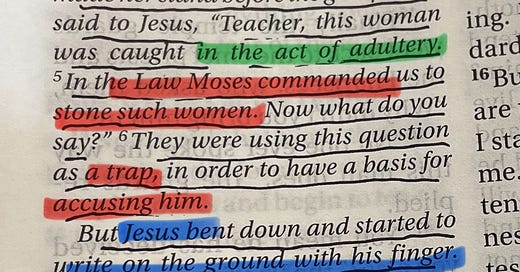The Woman Caught in Adultery
“The teachers of the law and the Pharisees brought in a woman caught in adultery. They made her stand before the group…” (John 8:3)
Observation: It says a woman caught in adultery.
But adultery takes two people.
Where is the man?
The Law of Moses required that both parties be punished.
The Law of Moses actually says:
“If a man is found sleeping with another man’s wife, both the man who slept with her and the woman must die. You must purge the evil from Israel.”
(Deuteronomy 22:22, also see Leviticus 20:10)
They ignored the man.
They applied the law selectively.
That already shows this wasn’t about holiness; it was a setup.
The Trap
“They were using this question as a trap, in order to have a basis for accusing him.” (John 8:6)
Under Roman law, the Jews were not allowed to execute anyone (see John 18:31).
If Jesus said, “Yes, stone her,” they could accuse Him of breaking Roman law.
If He said, “Don’t stone her,” they could accuse Him of breaking Moses’ law.
This was a trap, but a weak one.
Jesus bent down and wrote on the ground
“But Jesus bent down and started to write on the ground with his finger.” (John 8:6)
Connection to the Old Testament:
“When the LORD finished speaking to Moses on Mount Sinai, he gave him the two tablets of the covenant law, the tablets of stone inscribed by the finger of God.” (Exodus 31:18)
The same finger that wrote the Ten Commandments now writes in the dirt.
He is the Divine Author of the Law standing before them.
We are made from dust (Genesis 2:7) and return to dust (Genesis 3:19).
He writes on what we are made from — a subtle reminder that we are all subject to sin and death.
The Confrontation
“Let any one of you who is without sin be the first to throw a stone at her.” (John 8:7)
Only one person there was without sin: Jesus Himself.
Yet He does not condemn.
They heard… and were moved
“At this, those who heard began to go away one at a time…” (John 8:9)
Notice: It says “those who heard.”
Jesus often said:
“Whoever has ears, let them hear.” (Matthew 11:15)
“They have ears but cannot hear, eyes but cannot see.” (Jeremiah 5:21; Ezekiel 12:2)
In this moment, they actually heard and their hearts were moved.
Conviction set in. One by one, they left.
Only Jesus and the woman remain
“Jesus straightened up and asked her, ‘Woman, where are they? Has no one condemned you?’” (John 8:10)
“No one, sir,” she said. “Then neither do I condemn you,” Jesus declared. “Go now and leave your life of sin.” (John 8:11)
The only one who could condemn does not.
Instead, He forgives and releases her from shame.
Then He gives a sobering reminder:
“Go now and sin no more.” (John 8:11)
Powerful Layers in This Story
Legal context: They quote “Moses’ Law” but break it themselves by only bringing the woman (Deut. 22:22).
Trap context: They try to trap Jesus between Roman law and Jewish law (John 18:31).
Divine context: The finger of God that wrote the Ten Commandments writes again, this time on dust — a picture of humanity and our frailty (Exodus 31:18; Genesis 2:7).
Spiritual context: Jesus exposes that all have sinned (Romans 3:23).
Mercy context: The only one without sin chooses mercy over judgment (James 2:13).
Transformation context: Forgiveness is not a free pass — it comes with a call to turn from sin.
Final Reflection
This passage is breathtaking even on the surface — but when you layer in the Old Testament and the depth of who Jesus is, it becomes even more beautiful:
We are dust. He is the finger that wrote the law.
We are guilty. He alone is sinless.
We deserve death. He offers mercy.
We are sent away forgiven — but with a mission to “go and sin no more.”



